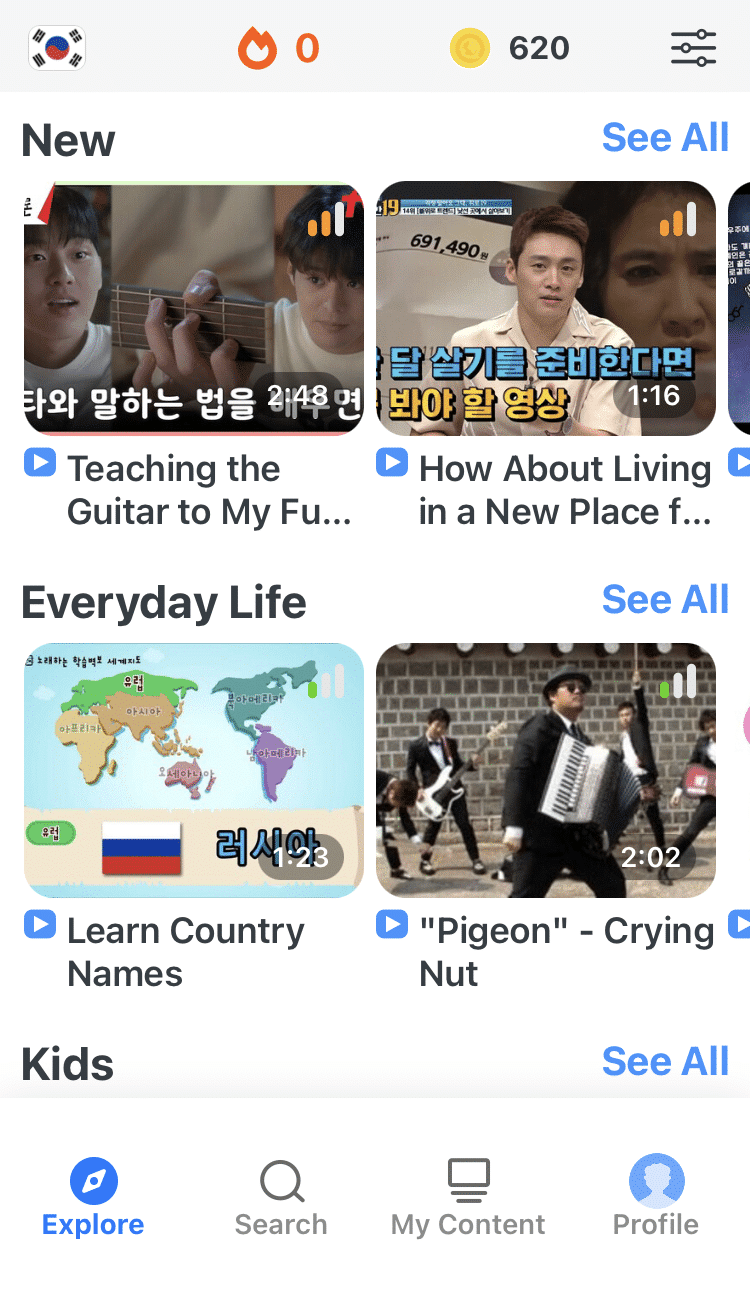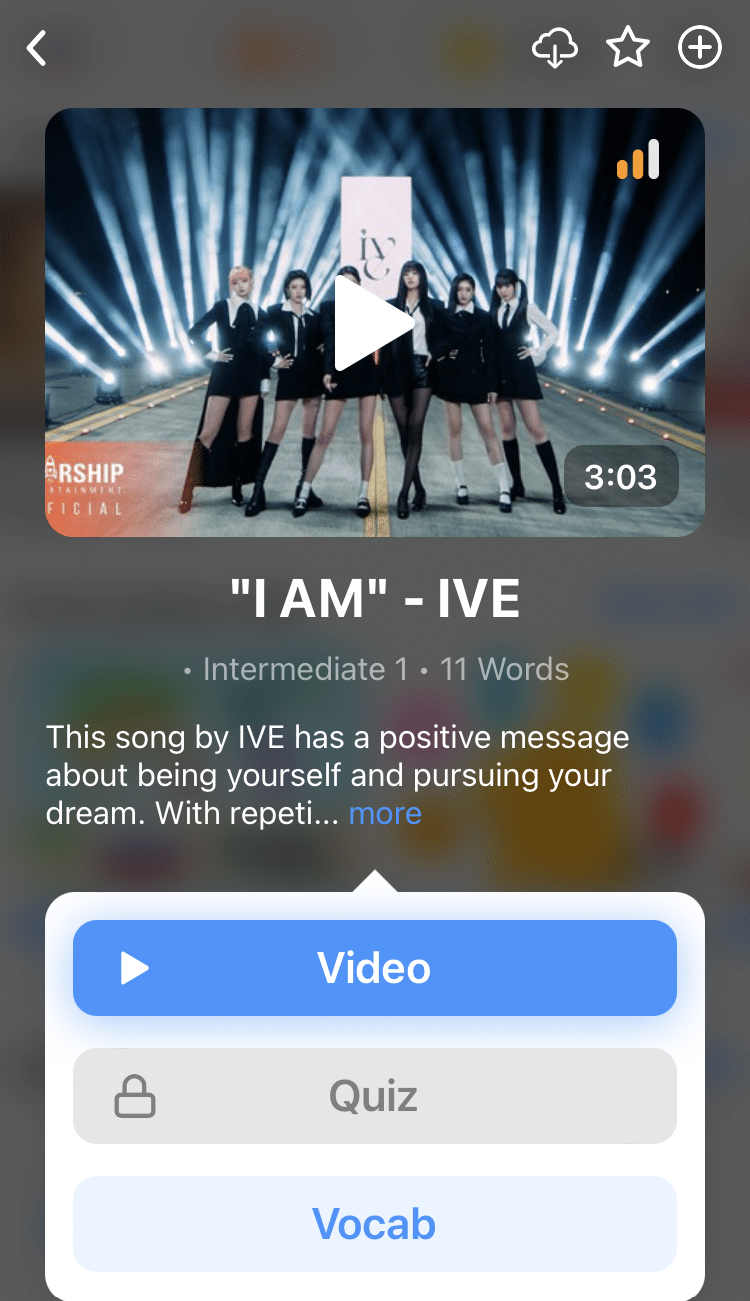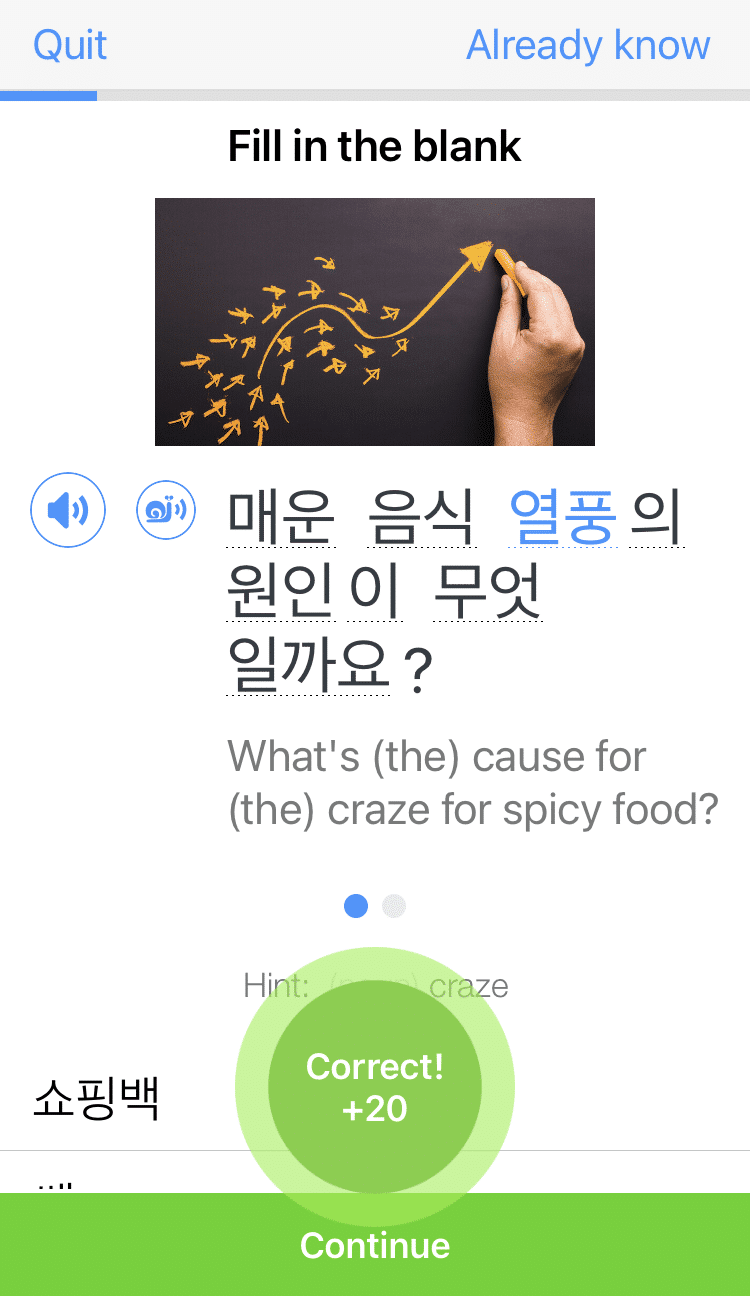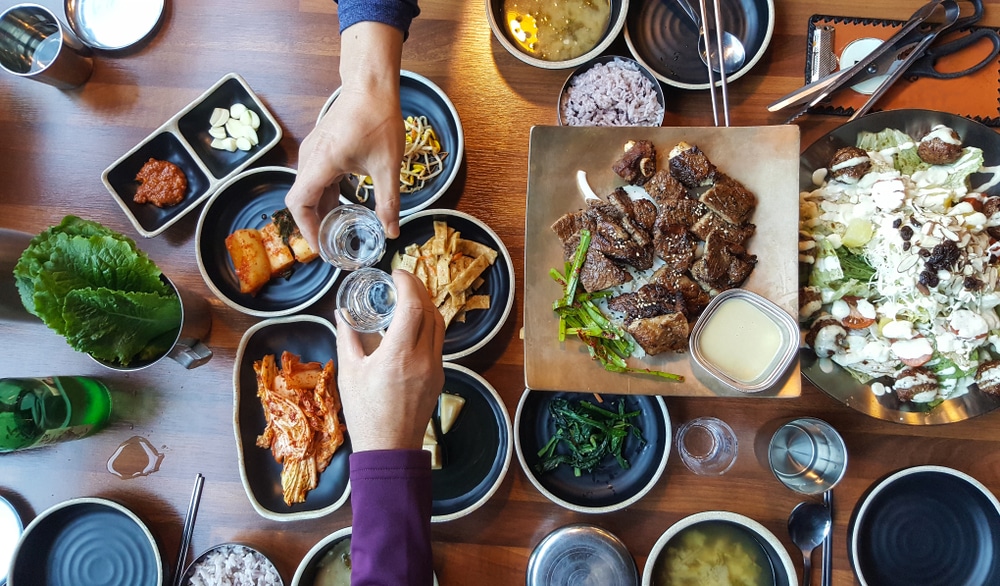
How to Order Korean BBQ in Korean
If there’s one type of Korean cuisine you shouldn’t miss out on, Korean BBQ, known as 고기구이 (gogi-gui).
So, if you’ve yet to try it, here’s a guide to help you with how to order, key vocabulary and more.
Contents
Download: This blog post is available as a convenient and portable PDF that you can take anywhere. Click here to get a copy. (Download)
What is Korean BBQ?
It’s grilled meat, yes. And you’ve had your steaks, meatloaves, burgers and hot dogs, topped with ketchup, mustard, barbeque sauce, whatever. So what’s so special about a Korean BBQ?
Put simply, it’s an entirely different ballgame.
Here’s how it goes.
How does Korean BBQ work
When you enter a Korean BBQ place, known as 고기집 (gogijip)—meat house, you’ll be seated at a table with a grill on (or within) it. There may be a vent tube over it to suck up any smoke that results from cooking.
Once you look at your options, you can start ordering whatever meats you’d like. I recommend you start with the plainer meats first, so that you can really appreciate the explosive tastes of the marinated meats afterwards.
Before the meat comes out, you’ll be given a bunch of mostly vegetarian side dishes, including a plate of large lettuce leaves ( 상추 (sangchu)) and possibly perilla leaves ( 깻잎 (kkaetnip)). There will also be a variety of dipping sauces.
The sauces typically include:
- 쌈장 (ssamjang) — spicy soybean-based past
- 기름장 (gireumjang) — sesame oil with salt and pepper
- 고추장 (gochujang) — spicy pepper paste
Nibble on the side dishes as you wait for your order of meat(s), which can come out one-by-one in type, or all together in a set.
It’s common for the server to do the grilling for you as you sit back and relax. You can also get a pair of tongs and grill for yourself. While cooking the meat, feel free to toss in some side dish foods onto the grill. I highly recommend you grill whatever kimchi you get—the kimchi juice can seep into the meat and give it a nice kick.
As the meat sizzles to perfection, you can think of your plan of attack on how to eat it. You have three main ways to do so:
- Eat the meat straight off the grill. Makes sense if you’re the type to savor the taste of meat in its purest form.
- Dip the meat in one of the sauces before you eat it. I promise, those sauces will make a huge impact. Be adventurous, and feel free to dip the meat in multiple sauces.
- Make a 쌈 wrap. Put the meat in a lettuce leaf, add in any side dishes and sauces you desire (even other meats), wrap everything up and eat it whole.
No strict rules for this method—you can literally put whatever you want.
Bon appétit, or as we say in Korean, 맛있게 드세요 (Masitge deuseyo)!
Why Korean BBQ is important in Korean Culture?
It’s not just that it’s delicious. Korean BBQ has a lot of cultural context to it.
Korean BBQ is usually a very social event. It’s often an experience you share with multiple people. Plus, the meal you’ll all indulge in won’t just be a carnivore’s fantasy. You’re getting a diverse colorful spread that covers much of the food pyramid, a hearty, healthy and filling feast.
Throughout the meal, it’s common for folks to make a lettuce 쌈 wrap and give it to someone else to eat. This wrap should be ideal and stuffed with ingredients, enough to make the receiving person resemble a cheek-stuffed chipmunk while chewing. This is a sign of respect and care.
Basically, a Korean BBQ event instills a sense of camaraderie and etiquette. Sharing the savory meal, clinking soju glasses, chatting about anything and everything, all as the smoke of the grill continues to drift to your nostrils and get you hungry all over again…the Korean BBQ space a uniquely warm, cozy atmosphere.
History of Korean BBQ
Grilled meat in Korea dates back to the 고구려 (Goguryeo) era, roughly 37 BC to 668 AD. Back then, meat was a dish reserved for royalty. A skewered meat known as 맥적 (maekjeok), the ancestor to the modern 불고기 (bulgogi), was a common choice.
Korean BBQ as we know it now had its strongest roots around the Korean War. In the 1950s, American soldiers stationed in Korea frequently interacted with the natives. One of the things they shared were Western grilling methods previously unfamiliar to Koreans.
The rest is, as they say, history. As meat became more available for common consumption, Koreans implemented their own native ingredients and eating habits to the world of BBQ. The delicious fruits of their labor are what we enjoy today.
How to Order Korean BBQ
If you know the basics of ordering food in Korean, then ordering BBQ won’t be hard at all.
____ 주세요 – Please give me ___
Transliteration: juseyo
If there’s anything you need, whether it’s the menu or a fork, just say the item in question and follow it up with 주세요. For example, if you want lettuce leaves, you can say 상추 주세요 .
_____ 일/이/삼 인분 주세요 – Please give me one/two/three serving(s) of _____
Transliteration: il/i/sam inbun juseyo
Use Sino-Korean numbers to describe how many servings you would like. One serving of meat is generally enough for one person. If you’re with a group, take into account how much the others may eat a particular type of meat. Don’t worry if a serving ends up not being enough—you can always order more later.
소주잔 한/두/세 개 주세요 – Please give me one/two/three soju glass(es)
Transliteration: sojujan han/du/se gae juseyo
The smoky meat always pairs well with Korean soju. It’s common to get a few bottles with your order (to share), but since you’re not an animal, you won’t be slurping straight out of the soju bottle. No, you’ll have to ask for a small elegant glass, or 잔, made specially for soju consumption.
You should also get glasses for other drinks as well. Just swap 소주 in the sentence with your beverage of choice.
You’ll be using native Korean numbers this time when counting glasses!
반찬 좀 더 주세요 – Please give me more side dishes
Transliteration: banchan jom deo juseyo
Believe me, they go quickly. Extra servings of side dishes are usually provided free of charge. Make sure to stack up any clean plates and give it to your server before you get the next batch.
불판 갈아 주세요 – Please clean/scrape the grill pan
Transliteration: bulpan gara juseyo
Over time, the grill pan will become charred and crusty (especially if you eat primarily non-marinated meats). When it gets mildly discolored, you can ask the server to clean it for you. They can scrape off the mess so that you have a clean grill surface.
불판 바꿔 주세요 – Please replace the grill pan
Transliteration: bulpan bakkwo juseyo
When the grill pan becomes very scorched, it may be time to get an entirely new pan altogether. Ask for a replacement so you can get back to cooking ASAP.
Korean BBQ Meat
In Korea, pork is the most popular BBQ meat, especially loved for its fatty content. Beef, being more expensive and decadent, is considered a more “luxurious” meat that’s commonly saved for celebrations. Chicken, in all its gustatory pliancy, is also a strong member of the BBQ tier list.
Besides the typical cuts you’d expect would be consumed, Koreans also use other parts of the animal that you may have never thought of eating!
In most Korean BBQ joints, here are the meats you can typically expect:
- 생갈비 (saeng-galbi) — plain beef rib
- 양념소갈비 (yangnyeom-so-galbi) — seasoned/marinated beef rib
- 꽃살 (kkochsal) — boneless beef short rib
- 불고기 (bulgogi) — bulgogi (fine marinated beef)
- 매운불고기 (maeun-bulgogi) — spicy bulgogi
- 차돌박이 (chadolbag-i) — beef brisket
- 우설 (useol) — beef tongue
- 안창살 (anchangsal) — skirt steak
- 양념돼지갈비 (yangnyeom-dwaeji-galbi) — marinated pork rib
- 돼지불고기 (dwaeji-bulgogi) — pork bulgogi
- 삼겹살 (samgyeobsal) — pork belly
- 항정살 (hangjeongsal) — pork jowl
- 목살 (mogsal) — pork neck
- 닭불고기 (dak-bulgogi) — chicken bulgogi
- 닭갈비 (dak-galbi) — marinated chicken
- 등심 (deungsim) — sirloin
- 곱창 (gobchang) — small intestines (can be beef or pork)
- 대창 (daechang) — large intestines (can be beef or pork)
If this post made you hungry, then I’ve done my job.
If you’re lucky and there’s a Korean BBQ place near you, gather some buddies and head on over.
Otherwise, the next time you book a trip to Korea, make a 고기집 one of your first stops.
If you enjoyed this post, you're already halfway to having the time of your life learning Korean with FluentU!
FluentU makes it possible to learn with K-pop videos, funny commercials, entertaining web series and more. Just a quick look will give you an idea of the variety of FluentU videos on offer:
FluentU really takes the grunt work out of learning languages, leaving you with nothing but engaging, effective and efficient learning. It's already hand-picked the best videos for you (which are organized by level and topic), so all you have to do is simply choose any video that strikes your fancy to get started.
Each word in the interactive captions comes with a definition, audio, image, example sentences and more.
Access a complete interactive transcript of every video under the Dialogue tab, and easily review words and phrases from the video under Vocab.
You can use FluentU’s unique Quiz Mode to learn the vocabulary and phrases from the video through fun questions.
FluentU keeps track of what you're learning, and tells you exactly when it's time for review, giving you a 100% personalized experience.
Review sessions use video context to help embed the words in your memory.
Start using the FluentU website on your computer or tablet or, better yet, download the FluentU app from the iTunes or Google Play store. Click here to take advantage of our current sale! (Expires at the end of this month.)
And One More Thing...








